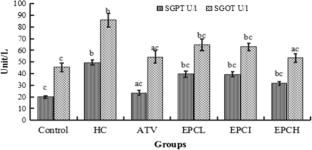In-silico elucidation of phytoconstituents against 1LPB protein and anti-dyslipidaemic activity of Psoralea corylifolia Linn leaf extract
Abstract
Psoralea corylifolia L. has been used in traditional Chinese and Ayurvedic medicine systems for management of various diseases. The various phytochemical constituents work in orchestric manner to treat diverse illnesses. Current pharmaco-therapies shown beneficiary role in treatment of dyslipidaemia but facing life threatening side effects. The usage of herbs increased worldwide and paves the way for development of pharmaceuticals for hyperlipidemia treatment. The main objective of present work was to investigate anti-hyperlipidemic activity and in-silico pancreatic lipase inhibitory potential of Psoralea corylifolia L. (PC) leaf extract. The existence of several phytoconstituents was confirmed by the chromatographic research and mainly includes the flavonoids and furanocoumarins. All studied phytoconstituents were found to have superior binding affinity than standard orlistat (− 7.1 kcal/mol), with docking score ranges from − 10.6 to − 7.3 kcal/mol. At 200 mg/kg/day the ethanolic leaf extract demonstrated highest lipid lowering action. Ethanolic leaf extract of Psoralea corylifolia revealed evidential antihyperlipidemic potential in a concentration dependent manner (P < 0.01). The serum lipid profile (LDL, VLDL, TG, TC) dropped firmly and HDL elevated in hyperlipidemic rats treated with plant extract compared with the hyperlipidemic group rats (P < 0.01). The hepatic TC and TG abruptly increased in hyperlipidemic rats and significantly reduced in hyperlipidemic rats administered with EPC compared with the control group (P < 0.01). The hyperlipidemic rats treated with atorvastatin and PC at different doses shown evidentiary increase in secretion of TC and TG compared with the hyperlipidemic group rats. The study results proposed that EPC leaf extract demonstrated noteworthy antihyperlipidemic action. The findings of docking study recommend utilization of the best ligands experimentally to develop novel anti-obesity agents.


 求助内容:
求助内容: 应助结果提醒方式:
应助结果提醒方式:


